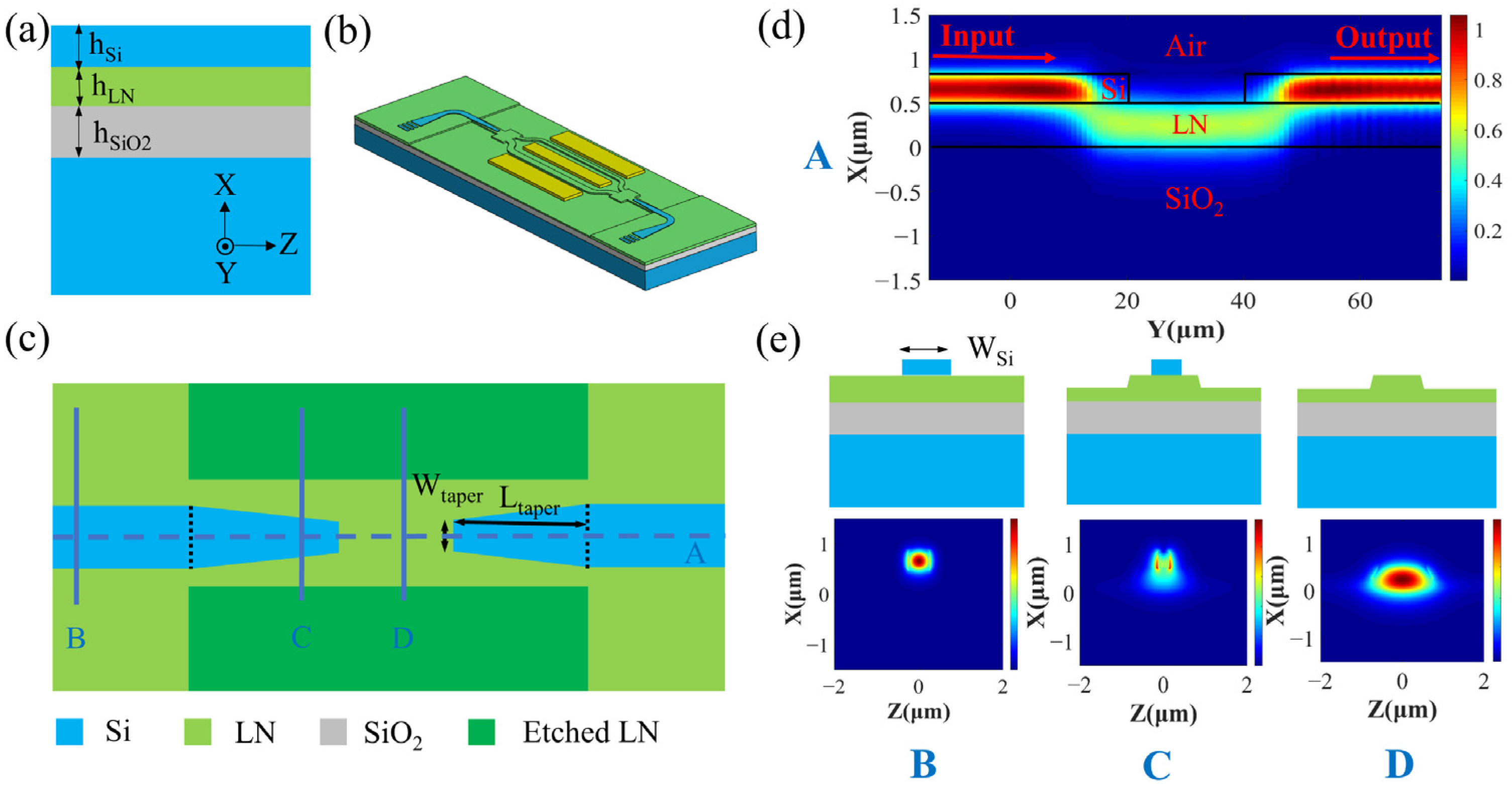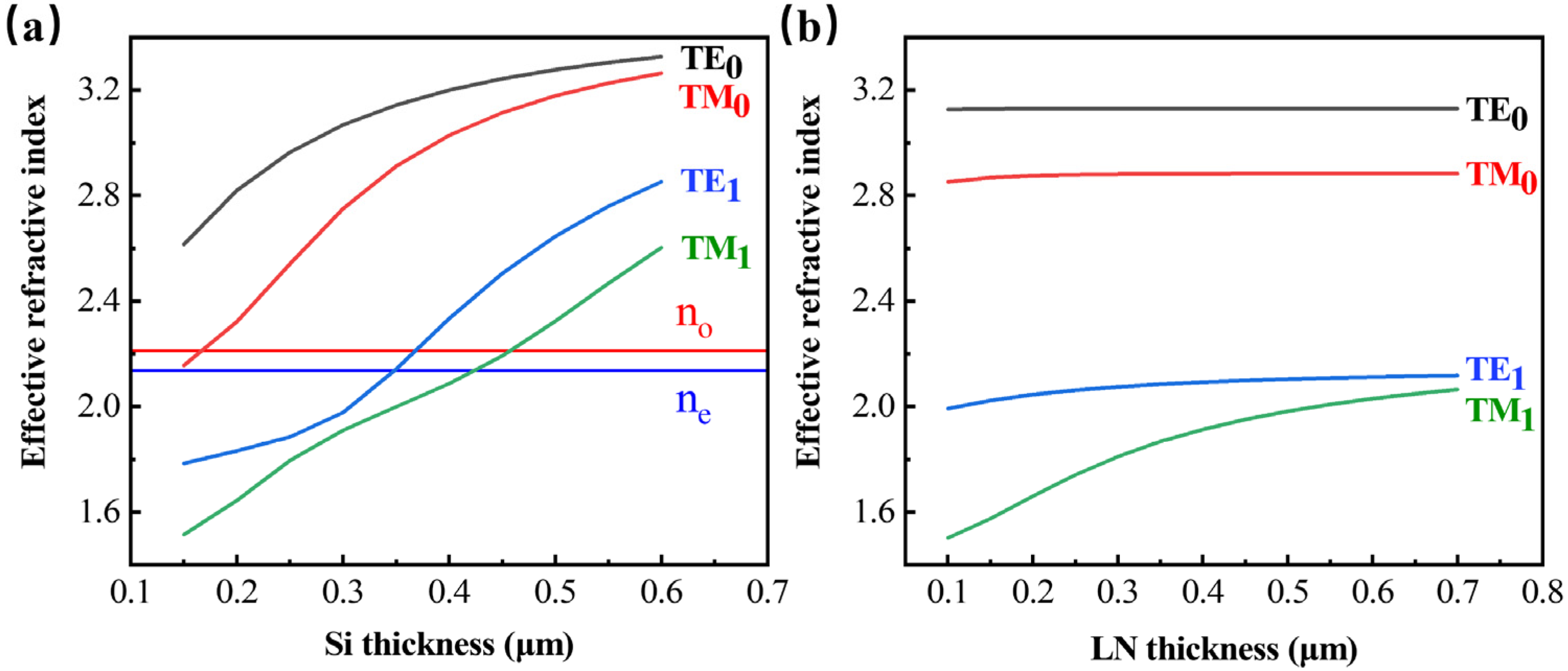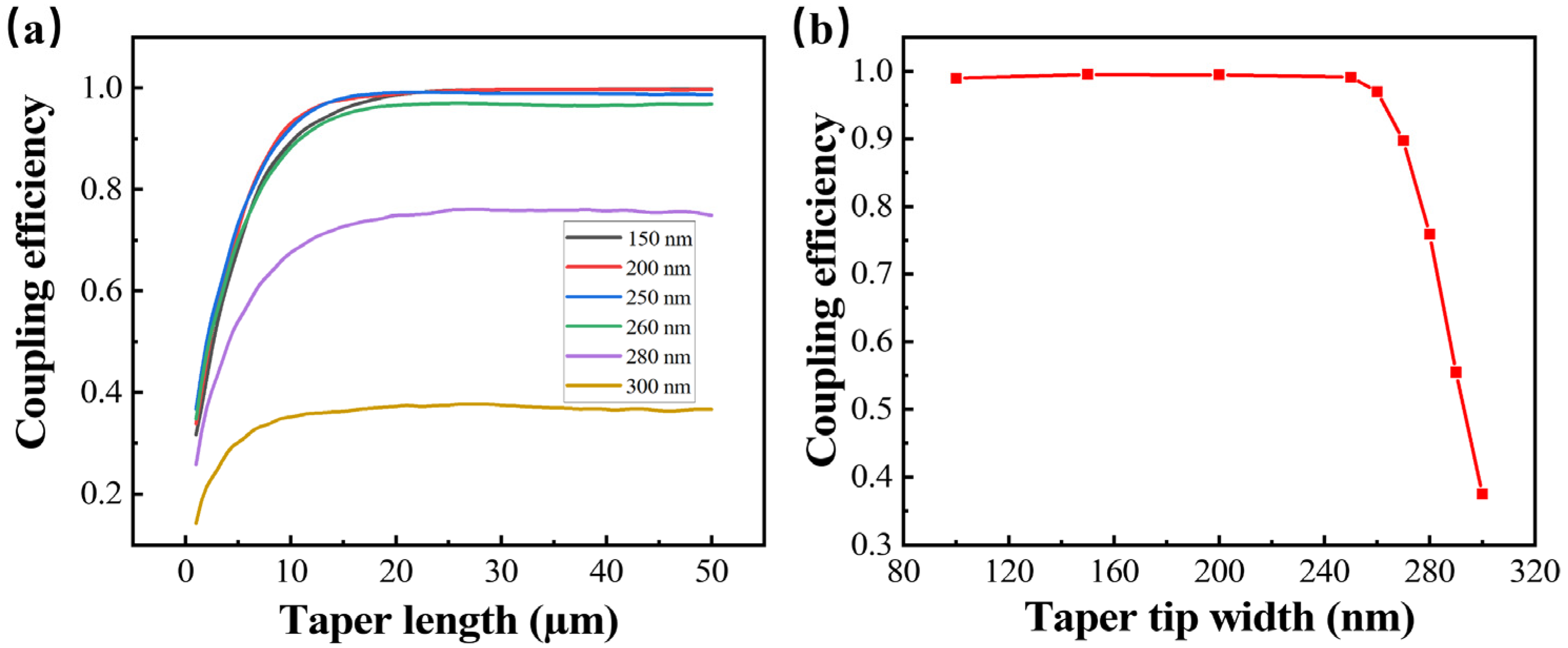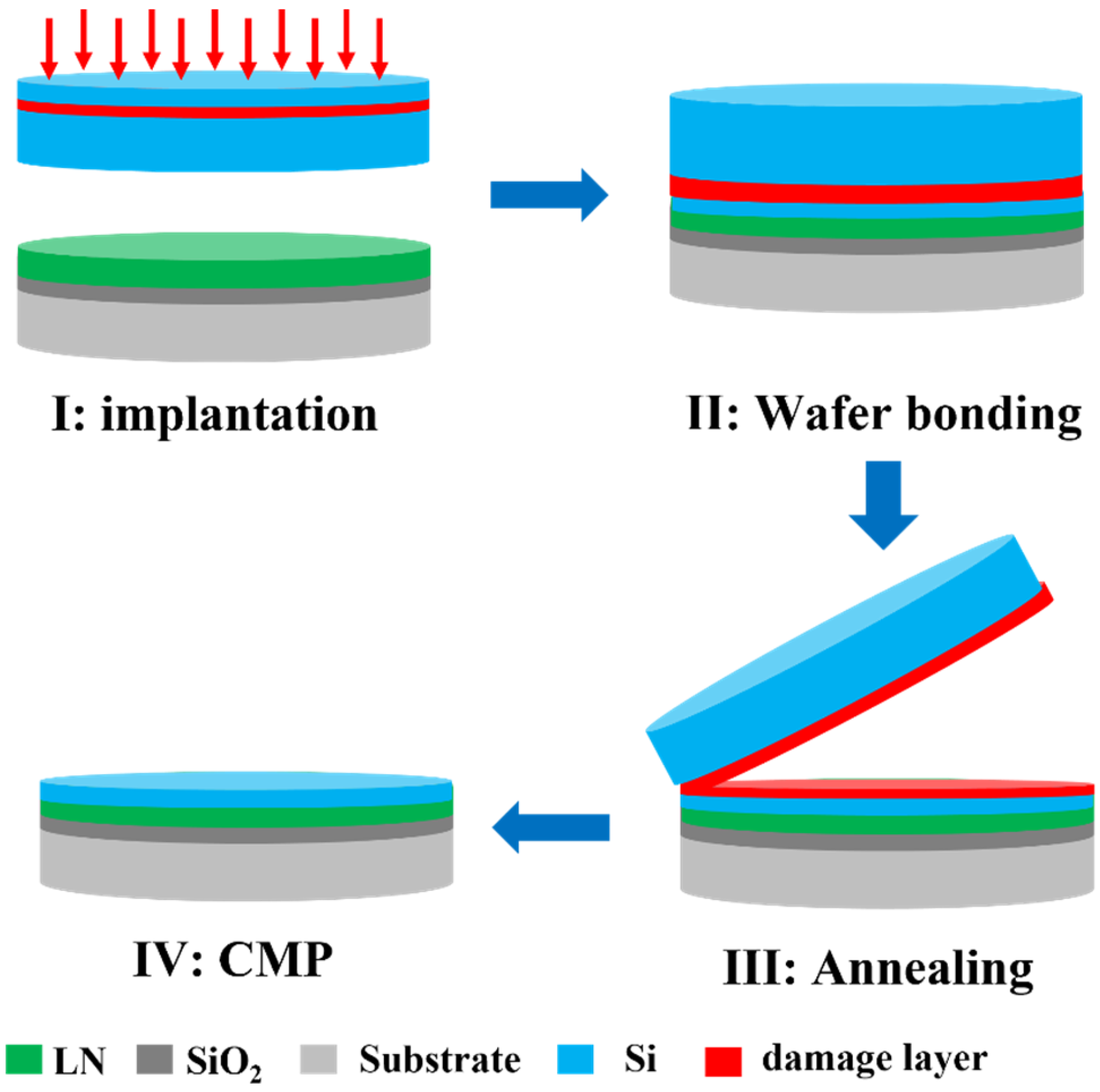Wafer-Scale Fabrication of Silicon Film on Lithium Niobate on Insulator (LNOI)
Abstract
1. Introduction
2. Structure Simulation
3. Structure Fabrication and Characterization
4. Conclusions
Author Contributions
Funding
Data Availability Statement
Conflicts of Interest
References
- Okamoto, K.; Ishida, K. Fabrication of silicon reflection-type arrayed-waveguide gratings with distributed bragg reflectors. Opt. Lett. 2013, 38, 3530–3533. [Google Scholar] [CrossRef] [PubMed]
- Thomson, D.J.; Hu, Y.; Reed, G.T.; Fedeli, J.M. Low loss MMI couplers for high performance MZI modulators. IEEE Photonics Technol. Lett. 2010, 22, 1485–1487. [Google Scholar] [CrossRef]
- Liu, A.S.; Liao, L.; Rubin, D.; Nguyen, H.; Ciftcioglu, B.; Chetrit, Y.; Izhaky, N.; Paniccia, M. High-speed optical modulation based on carrier depletion in a silicon waveguide. Opt. Express 2007, 15, 660–668. [Google Scholar] [CrossRef] [PubMed]
- Gardes, F.Y.; Reed, G.T.; Emerson, N.G.; Png, C.E. A sub-micron depletion-type photonic modulator in silicon on insulator. Opt. Express 2005, 13, 8845–8854. [Google Scholar] [CrossRef]
- Liu, A.S.; Jones, R.; Liao, L.; Samara-Rubio, D.; Rubin, D.; Cohen, O.; Nicolaescu, R.; Paniccia, M. A high-speed silicon optical modulator based on a metal-oxide-semiconductor capacitor. Nature 2004, 427, 615–618. [Google Scholar] [CrossRef]
- Hochberg, M.; Baehr-Jones, T.; Wang, G.X.; Shearn, M.; Harvard, K.; Luo, J.D.; Chen, B.Q.; Shi, Z.W.; Lawson, R.; Sullivan, P.; et al. Terahertz all-optical modulation in a silicon-polymer hybrid system. Nat. Mater. 2006, 5, 703–709. [Google Scholar] [CrossRef]
- Koeber, S.; Palmer, R.; Lauermann, M.; Heni, W.; Elder, D.L.; Korn, D.; Woessner, M.; Alloatti, L.; Koenig, S.; Schindler, P.C.; et al. Femtojoule electro-optic modulation using a silicon-organic hybrid device. Light Sci. Appl. 2015, 4, e255. [Google Scholar] [CrossRef]
- Eltes, F.; Mai, C.; Caimi, D.; Kroh, M.; Popoff, Y.; Winzer, G.; Petousi, D.; Lischke, S.; Ortmann, J.E.; Czornomaz, L.; et al. A BaTiO3-based electro-optic pockels modulator monolithically integrated on an advanced silicon photonics platform. J. Light. Technol. 2019, 37, 1456–1462. [Google Scholar] [CrossRef]
- Guo, X.; Shao, L.; He, L.; Luke, K.; Morgan, J.; Sun, K.; Gao, J.; Tzu, T.-C.; Shen, Y.; Chen, D.; et al. High-performance modified uni-traveling carrier photodiode integrated on a thin-film lithium niobate platform. Photonics Res. 2022, 10, 1338–1343. [Google Scholar] [CrossRef]
- Vivien, L.; Marris-Morini, D.; Fedeli, J.M.; Rouviere, M.; Damlencourt, J.F.; El Melhaoui, L.; Le Roux, X.; Crozat, P.; Mangeney, J.; Cassan, E.; et al. Metal-semiconductor-metal Ge photodetectors integrated in silicon waveguides. Appl. Phys. Lett. 2008, 92, 151114. [Google Scholar] [CrossRef]
- Tian, B.; Wang, Z.; Pantouvaki, M.; Absil, P.; Van Campenhout, J.; Merckling, C.; Van Thourhout, D. Room temperature o-band DFB laser array directly grown on (001) silicon. Nano. Lett. 2017, 17, 559–564. [Google Scholar] [CrossRef]
- Xiang, C.; Liu, J.Q.; Guo, J.; Chang, L.; Wang, R.N.; Weng, W.L.; Peters, J.; Xie, W.Q.; Zhang, Z.Y.; Riemensberger, J.; et al. Laser soliton microcombs heterogeneously integrated on silicon. Science 2021, 373, 99–103. [Google Scholar] [CrossRef]
- Yonekura, K.; Jin, L.H.; Takizawa, K. Measurement of dispersion of effective electro-optic coefficients r13e and r33e of non-doped congruent LiNbO3 crystal. Jpn. J. Appl. Phys. 2008, 47, 5503–5508. [Google Scholar] [CrossRef]
- Luke, K.; Kharel, P.; Reimer, C.; He, L.Y.; Loncar, M.; Zhang, M. Wafer-scale low-loss lithium niobate photonic integrated circuits. Opt. Express 2020, 28, 24452–24458. [Google Scholar] [CrossRef]
- Zhang, M.; Wang, C.; Cheng, R.; Shams-Ansari, A.; Loncar, M. Monolithic ultra-high-Q lithium niobate microring resonator. Optica 2017, 4, 1536–1537. [Google Scholar] [CrossRef]
- Xu, M.; He, M.; Zhang, H.; Jian, J.; Pan, Y.; Liu, X.; Chen, L.; Meng, X.; Chen, H.; Li, Z.; et al. High-performance coherent optical modulators based on thin-film lithium niobate platform. Nat. Commun. 2020, 11, 3911. [Google Scholar] [CrossRef]
- Zhang, M.; Wang, C.; Kharel, P.; Zhu, D.; Lončar, M. Integrated lithium niobate electro-optic modulators: When performance meets scalability. Optica 2021, 8, 652–667. [Google Scholar] [CrossRef]
- He, M.B.; Xu, M.Y.; Ren, Y.X.; Jian, J.; Ruan, Z.L.; Xu, Y.S.; Gao, S.Q.; Sun, S.H.; Wen, X.Q.; Zhou, L.D.; et al. High-performance hybrid silicon and lithium niobate mach-zehnder modulators for 100 gbit s−1 and beyond. Nat. Photonics. 2019, 13, 359–364. [Google Scholar] [CrossRef]
- Wang, C.; Zhang, M.; Chen, X.; Bertrand, M.; Shams-Ansari, A.; Chandrasekhar, S.; Winzer, P.; Loncar, M. Integrated lithium niobate electro-optic modulators operating at cmos-compatible voltages. Nature 2018, 562, 101–104. [Google Scholar] [CrossRef]
- Wang, D.; Ding, T.T.; Zheng, Y.L.; Chen, X.F. Cascaded sum-frequency generation and electro-optic polarization coupling in the PPLNOI ridge waveguide. Opt. Express 2019, 27, 15283–15288. [Google Scholar] [CrossRef]
- Mackwitz, P.; Rusing, M.; Berth, G.; Widhalm, A.; Muller, K.; Zrenner, A. Periodic domain inversion in x-cut single-crystal lithium niobate thin film. Appl. Phys. Lett. 2016, 108, 152902. [Google Scholar] [CrossRef]
- Chen, L.; Nagy, J.; Reano, R.M. Patterned ion-sliced lithium niobate for hybrid photonic integration on silicon. Opt. Mater. Express 2016, 6, 2460–2467. [Google Scholar] [CrossRef]
- Wang, Y.W.; Chen, Z.H.; Cai, L.T.; Jiang, Y.P.; Zhu, H.B.; Hu, H. Amorphous silicon-lithium niobate thin film strip-loaded waveguides. Opt. Mater. Express 2017, 7, 4018–4028. [Google Scholar] [CrossRef]
- Jian, J.; Xu, P.F.; Chen, H.; He, M.B.; Wu, Z.R.; Zhou, L.D.; Liu, L.; Yang, C.C.; Yu, S.Y. High-efficiency hybrid amorphous silicon grating couplers for sub-micron-sized lithium niobate waveguides. Opt. Express 2018, 26, 29651–29658. [Google Scholar] [CrossRef] [PubMed]
- Weigel, P.O.; Zhao, J.; Fang, K.; Al-Rubaye, H.; Trotter, D.; Hood, D.; Mudrick, J.; Dallo, C.; Pomerene, A.T.; Starbuck, A.L.; et al. Bonded thin film lithium niobate modulator on a silicon photonics platform exceeding 100 GHz 3dB electrical modulation bandwidth. Opt. Express 2018, 26, 23728–23739. [Google Scholar] [CrossRef]
- Wang, J.; Xu, S.; Chen, J.; Zou, W. A heterogeneous silicon on lithium niobate modulator for ultra-compact and high-performance photonic integrated circuits. IEEE Photonics J. 2021, 13, 4900112. [Google Scholar] [CrossRef]
- Li, Q.; Zhu, H.; Zhang, H.; Cai, L.; Hu, H. Phase modulators in hybrid silicon and lithium niobate thin films. Opt. Mater. Express 2022, 12, 1314–1322. [Google Scholar] [CrossRef]
- Cai, J.; Guo, C.; Lu, C.; Lau, A.P.T.; Chen, P.; Liu, L. Design optimization of silicon and lithium niobate hybrid integrated traveling-wave mach-zehnder modulator. IEEE Photonics J. 2021, 13, 2200206. [Google Scholar] [CrossRef]
- Sun, S.; He, M.; Xu, M.; Gao, S.; Yu, S.; Cai, X. Hybrid silicon and lithium niobate modulator. IEEE J. Sel. Top. Quantum Electron. 2021, 27, 3300112. [Google Scholar] [CrossRef]
- Xu, Q.; Shao, Y.X.; Piao, R.Q.; Chen, F.; Wang, X.; Yang, X.F.; Wong, W.H.; Pun, E.Y.B.; Zhang, D.L. A theoretical study on rib-type photonic wires based on LiNbO3 thin film on insulator. Adv. Theory Simul. 2019, 2, 1900115. [Google Scholar] [CrossRef]
- Yu, X.R.; Wang, M.K.; Li, J.H.; Wu, J.Y.; Hu, Z.F.; Chen, K.X. Study on the single-mode condition for x-cut LNOI rib waveguides based on leakage losses. Opt. Express 2022, 30, 6556–6565. [Google Scholar] [CrossRef]
- Villa, J.J. Additional data on refractive-index of silicon. Appl. Opt. 1972, 11, 2102–2103. [Google Scholar] [CrossRef]
- Zhang, P.; Huang, H.J.; Jiang, Y.H.; Han, X.; Xiao, H.F.; Frigg, A.; Nguyen, T.G.; Boes, A.; Ren, G.H.; Su, Y.K.; et al. High-speed electro-optic modulator based on silicon nitride loaded lithium niobate on an insulator platform. Opt. Lett. 2021, 46, 5986–5989. [Google Scholar] [CrossRef]
- Saitoh, E.; Kawaguchi, Y.; Saitoh, K.; Koshiba, M. TE/TM-pass polarizer based on lithium niobate on insulator ridge waveguide. IEEE Photonics J. 2013, 5, 6600610. [Google Scholar] [CrossRef]








Publisher’s Note: MDPI stays neutral with regard to jurisdictional claims in published maps and institutional affiliations. |
© 2022 by the authors. Licensee MDPI, Basel, Switzerland. This article is an open access article distributed under the terms and conditions of the Creative Commons Attribution (CC BY) license (https://creativecommons.org/licenses/by/4.0/).
Share and Cite
Chen, Y.; Zhao, X.; Li, Z.; Ke, X.; Wang, C.; Zhou, M.; Li, W.; Huang, K.; Ou, X. Wafer-Scale Fabrication of Silicon Film on Lithium Niobate on Insulator (LNOI). Crystals 2022, 12, 1477. https://doi.org/10.3390/cryst12101477
Chen Y, Zhao X, Li Z, Ke X, Wang C, Zhou M, Li W, Huang K, Ou X. Wafer-Scale Fabrication of Silicon Film on Lithium Niobate on Insulator (LNOI). Crystals. 2022; 12(10):1477. https://doi.org/10.3390/cryst12101477
Chicago/Turabian StyleChen, Yang, Xiaomeng Zhao, Zhongxu Li, Xinjian Ke, Chengli Wang, Min Zhou, Wenqin Li, Kai Huang, and Xin Ou. 2022. "Wafer-Scale Fabrication of Silicon Film on Lithium Niobate on Insulator (LNOI)" Crystals 12, no. 10: 1477. https://doi.org/10.3390/cryst12101477
APA StyleChen, Y., Zhao, X., Li, Z., Ke, X., Wang, C., Zhou, M., Li, W., Huang, K., & Ou, X. (2022). Wafer-Scale Fabrication of Silicon Film on Lithium Niobate on Insulator (LNOI). Crystals, 12(10), 1477. https://doi.org/10.3390/cryst12101477




